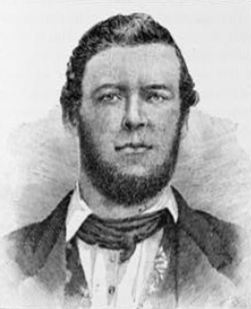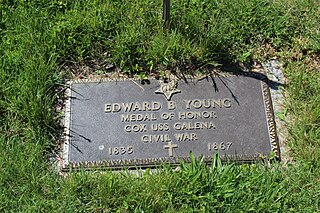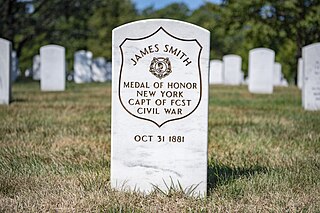
The second USS Metacomet was a wooden sidewheel steamer in the United States Navy during the American Civil War. The ship was named for Metacomet, a war chief of the Wampanoag Indians.
John Henry Denig was a United States Marine Corps sergeant serving aboard the USS Brooklyn during the American Civil War. He received the Medal of Honor for his actions in 1864 during the Battle of Mobile Bay.

Thomas H. Cripps was a native of Philadelphia, Pennsylvania who was awarded the U.S. Medal of Honor during the American Civil War. While serving in the Union Navy as a quartermaster aboard the USS Richmond, he operated one of that's ship's guns under heavy enemy fire for two hours during the Battle of Mobile Bay, Alabama on August 5, 1864, helping to damage the CSS Tennessee and destroy artillery batteries of the Confederate States Army at Fort Morgan, even as the enemy's shell and shot damaged his ship and killed several of his fellow crewmen. For those actions, he was awarded his nation's highest honor for bravery on December 31, 1864.

James Barnum was a boatswain’s mate in the United States Navy stationed aboard the Union ironclad USS New Ironsides during the American Civil War. He received the Medal of Honor for his actions during the First and Second Battle of Fort Fisher in December 1864 and January 1865.

William Campbell was a sailor in the U.S. Navy during the American Civil War. He received the Medal of Honor for his actions during the Second Battle of Fort Fisher on January 15, 1865.
James Martin II was a native of Ireland who served in the U.S. Marine Corps during the mid-19th century. Rising up through the ranks from private to sergeant while fighting for the federal government of the United States (Union) during the American Civil War, he displayed conspicuous bravery on August 5, 1864, while serving aboard the USS Richmond. Operating one of that ship's guns under heavy enemy fire for two hours during the Battle of Mobile Bay, Alabama, he helped to damage the CSS Tennessee and destroy artillery batteries of the Confederate States Army at Fort Morgan, even as the enemy's shell and shot damaged his ship and killed several of his shipmates. In recognition of his gallantry, he was presented with the Medal of Honor, the United States' highest award for valor, on December 31, 1864.
John Smith was a Union Navy sailor in the American Civil War and a recipient of the U.S. military's highest decoration, the Medal of Honor, for his actions at the Battle of Mobile Bay.

Edward B. Young was a Union Navy sailor in the American Civil War and a recipient of the U.S. military's highest decoration, the Medal of Honor, for his actions at the Battle of Mobile Bay.

Hendrick Sharp was a Union Navy sailor in the American Civil War and a recipient of the U.S. military's highest decoration, the Medal of Honor, for his actions at the Battle of Mobile Bay.

James Smith was a Union Navy sailor in the American Civil War and a recipient of the U.S. military's highest decoration, the Medal of Honor, for his actions at the Battle of Mobile Bay.
Lebbeus Simkins was a Union Navy sailor in the American Civil War and a recipient of the U.S. military's highest decoration, the Medal of Honor, for his actions at the Battle of Mobile Bay.
Alexander H. Truett (1833–1898) was a Union Navy sailor in the American Civil War and a recipient of the U.S. military's highest decoration, the Medal of Honor, for his actions at the Battle of Mobile Bay.
William Jones was a Union Navy sailor in the American Civil War and a recipient of the U.S. military's highest decoration, the Medal of Honor, for his actions at the Battle of Mobile Bay.
John H. James was a Union Navy sailor in the American Civil War and a recipient of the U.S. military's highest decoration, the Medal of Honor, for his actions at the Battle of Mobile Bay.
Adam Duncan was a Union Navy sailor in the American Civil War and a recipient of the U.S. military's highest decoration, the Medal of Honor, for his actions at the Battle of Mobile Bay.

Chief Boatswain's Mate William Densmore was a Union Navy sailor in the American Civil War and a recipient of the U.S. military's highest decoration, the Medal of Honor, for his actions at the Battle of Mobile Bay.
Richard Dennis was a Union Navy sailor in the American Civil War and a recipient of the U.S. military's highest decoration, the Medal of Honor, for his actions at the Battle of Mobile Bay.
Nicholas Irwin was a Union Navy sailor in the American Civil War and a recipient of the U.S. military's highest decoration, the Medal of Honor, for his actions at the Battle of Mobile Bay.
William Phinney was a Union Navy sailor in the American Civil War and a recipient of the U.S. military's highest decoration, the Medal of Honor, for his actions at the Battle of Mobile Bay.

Patrick Murphy was a Union Navy sailor in the American Civil War and a recipient of the U.S. military's highest decoration, the Medal of Honor, for his actions at the Battle of Mobile Bay. A native of Ireland, Murphy began his seafaring career as a teenager aboard merchant ships in the North Atlantic and served for two years in the Royal Navy. He joined the U.S. Navy after settling in Erie, Pennsylvania, and sailed the Great Lakes as a petty officer on USS Michigan. During the American Civil War, he served aboard USS Metacomet and distinguished himself in the action at Mobile Bay. He returned to Erie and USS Michigan after the war, continuing on that ship for twenty more years until retiring as a warrant officer.






